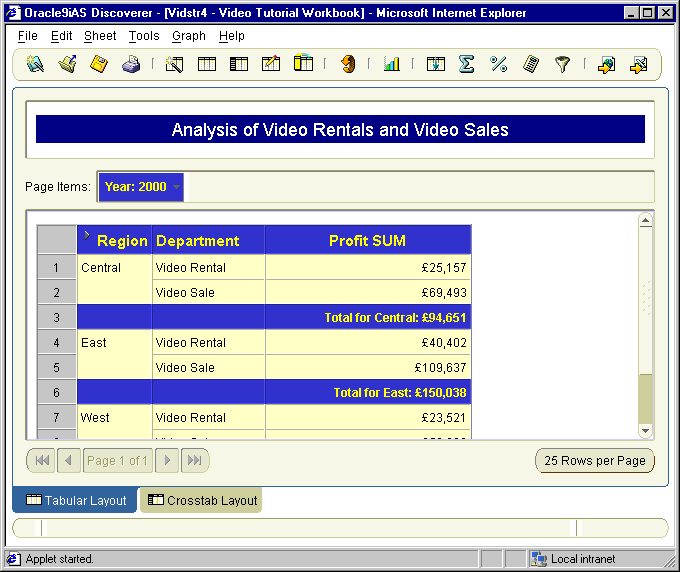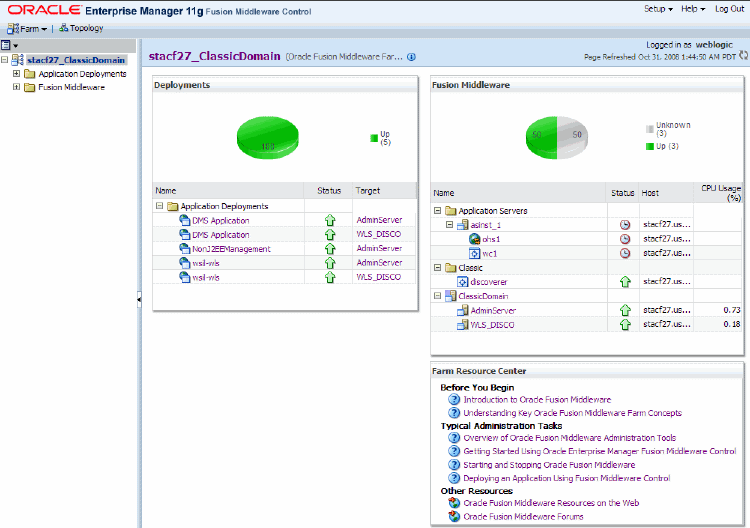Lastly, from Oracle 9iAS Release 2 9. Oracle Discoverer 4i and 9iAS have a three-tier architecture that integrates the Discoverer 'engine' into the Oracle 9i Application Server. Certain reports could then be subsequently published as portlets in Oracle Portal 9iAS, giving users a dashboard view of the organisations' performance, and allowing them to drill-through to full Discoverer Viewer reports if they wish to explore the report in more detail. Oracle Discoverer allows users to create charts and graphs to accompany their reports, and then to save and publish them for other users to view. Oracle Discoverer is an ad-hoc query tool used for reporting and analyzing data held in Oracle and other third-party databases. One further thing to bear in mind with Discoverer Desktop is that graphs built using it don't display when viewed using Discoverer Plus and Viewer, which use a different graphing mechanism the BI Beans Graphing Bean to that used by Discoverer Desktop. Discoverer Desktop is still around and as mentioned previously, is now bundled in with Discoverer Administrator as part of 9iDS. 
| Uploader: | Daishura |
| Date Added: | 18 March 2009 |
| File Size: | 64.44 Mb |
| Operating Systems: | Windows NT/2000/XP/2003/2003/7/8/10 MacOS 10/X |
| Downloads: | 59249 |
| Price: | Free* [*Free Regsitration Required] |
Compared to Discoverer Viewer and Plus, which are bundled in with 9ias on a per-user, per-processor or a site license, Discoverer Desktop has to be licensed on top of 9iAS which is the usual reason it's not used these days. However, with versions 4i, and now 9iAS, of Oracle Discoverer, it is now possible to deploy Discoverer reports using a web browser over the internet. The new Discoverer Portlets introduced with 9iAS 9.
Once you have installed the software and upgraded the EUL tables, the decision then becomes one of how best to deploy the new web-based disckverer of Oracle Discoverer.

Certain reports could then be subsequently published as portlets in Oracle Portal 9iAS, giving users a dashboard view of the organisations' performance, and allowing them to drill-through to full Discoverer Viewer reports if they wish to explore the report in more detail.
Lastly, from Oracle 9iAS Release 2 9. A summary of the different features found in the various Discoverer query tools would be as follows.
Unlike Discoverer Viewer and Plus worksheets and workbooks lists however, the output from Discoverer portlets are refreshed to a defined cycle once an hour, once every few hours or days, or whatever by Oracle Portal, which means that changes to the underlying data or End User Layer are not immediately reflected in the portlet.
Each portlet however has a 'view workbook' link which, when clicked, takes the user to the corresponding Discoverer Viewer worksheet which will have up-to-date data within it.
Oracle Discoverer allows users to create charts and graphs to accompany their reports, and then to save and publish them for other users to view. The old client-server Discoverer User Edition was however preserved but renamed as Discoverer Desktop, and one license for this version was also included in each Oracle 9iDS license. A typical approach would be for office-based, power users who wish to create and publish Discoverer reports to use a combination of Oracle Discoverer Desktop and Oracle Discoverer Plus.
The main advantage apart from the graphing capability of Discoverer Plus is that it gives you all of the functionality of Discoverer Desktop, without having to install software on the client's PC. Lastly, keep an eye on the Plus Consultancy website at http: Oracle Discoverer is an ad-hoc query tool used for reporting and analyzing data held in Oracle and other third-party databases.
Historically, Oracle Discoverer came in two versions - Oracle Discoverer 3. One disadvantage, however, is that as Discoverer Plus is written in java, it requires a slightly higher-specified client PC that was required for Discoverer Desktop.
One further thing to bear in mind with Discoverer Desktop is that graphs built using it don't display when viewed using Discoverer Plus and Viewer, which use a different graphing mechanism the BI Beans Graphing Bean to that used by Discoverer Desktop.

Discoverer Plus is delivered as a java applet embedded in a HTML page, and it uses the Oracle JInitiator plug-in provided with 9iAS to establish stateful, two way communication between the query tool, the 9iAS middle-tier, and the back-end Oracle database.
It doesn't allow you to create new workbooks or worksheets, and whilst you can apply parameters and 'slice-and-dice' the data in a report, you can't save the report afterwards.
Discoverer portlets are best thought of as a snapshot of data at a particular time, and work best as 'adverts' or 'tasters' for data in the customer database rather than a query tool in their own right.
WinWorld: Oracle Discoverer 4.x
Ignoring for this moment Discoverer Administrator, which hasn't changed much since version 3i, each of the Discoverer query tools performs a slightly different role, and has different capabilities and benefits. Any workbooks built using Discoverer Desktop will need their graphs redoing when viewed using Discoverer Plus and Viewer. Upgrading existing Discoverer 3i installations to either Discoverer 4i or Discoverer 9iAS is straightforward, and consists of three separate steps.
Oracle Discoverer 4i and 9iAS have a three-tier architecture that integrates the Discoverer 'engine' into the Oracle 9i Application Server. It presents data using 'business terms', allowing users to build reports by choosing data items from a business repository known as the 'End User Layerthen dragging and dropping them onto a report using a 'point and click' interface.
A typical implementation of Discoverer generally involves just Discoverer Viewer, Plus and Portlets, oracoe Discoverer Desktop used less and less, though there are some instances where Desktop is still useful. The Discoverer Viewer interface can be customised for an organisation discovsrer preference files on the 9iAS server, and the look and feel can be completely altered to match an organisation's intranet style. Reports are then distributed to users using Oracle Discoverer Viewer, which allows them to open reports, slice-and-dice the data, orracle print and export the data as required.
Discoverer Plus is a reimplementation of Discoverer Desktop, but written in Java. Users can apply parameters to the worksheets if required, and the data and reports are rendered in exactly the same look and feel as with Discoverer Viewer, although crosstabs can't be drilled in to or dimensions swapped around as the worksheet is essentially 'static'.
Oracle Discoverer
Discoverer Viewer is a useful complement to Discoverer Plus, and in many cases, clients roll out Discoverer Viewer to the majority of their users, with a handful of 'power users' using Discoverer Plus to create reports and graphs for the discoevrer users. Both applications were client-server Microsoft Windows application, and the only way to deploy reports to a wider audience was to use the unsupported method of using product such as Citrix Metaframe.
Discoverer Desktop is still around and as mentioned previously, is now bundled in with Discoverer Administrator as part of 9iDS. Each 9iDS 'seat' comes with one Discoverer Desktop and one Discoverer Administrator license, which means that if customers wish to deploy further copies of Discoverer Desktop xiscoverer other users, they either have to license more copies of 9iDS, or license Discoverer Desktop separately for each user.
However, there are one or two occasions when Discoverer Desktop is a better choice than Discoverer Plus - sometimes, print formatting is better with Discoverer Plus, and, as a native Windows application, it seems a bit faster and more responsive that working with a java applet. In addition to the worksheet portlet, there's also a 'list of workbooks' portlet, that displays, for a given public or private Discoverer connection, the list of available workbooks as defined in the End User Layer.

No comments:
Post a Comment